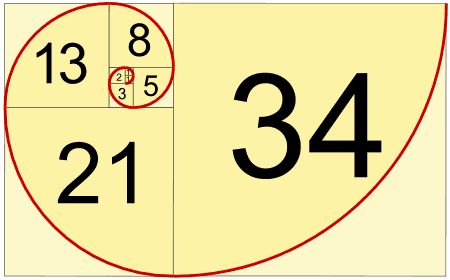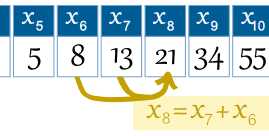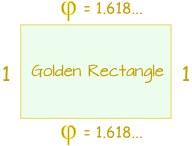Fibonacci Sequence - Not a mathematical equation it is a ratio.
The Fibonacci Sequence is the series of numbers:
0, 1, 1, 2, 3, 5, 8, 13, 21, 34, ...
The next number is found by adding up the two numbers before it.
- The 2 is found by adding the two numbers before it (1+1)
- Similarly, the 3 is found by adding the two numbers before it (1+2),
- And the 5 is (2+3),
- and so on!
Example: the next number in the sequence above would be 21+34 = 55
It is that simple!
Here is a longer list:
0, 1, 1, 2, 3, 5, 8, 13, 21, 34, 55, 89, 144, 233, 377, 610, 987, 1597, 2584, 4181, 6765, 10946, 17711, 28657, 46368, 75025, 121393, 196418, 317811, ...
Can you figure out the next few numbers?
Makes A Spiral
When you make squares with those widths, you get a nice spiral:

Do you see how the squares fit neatly together?
For example 5 and 8 make 13, 8 and 13 make 21, and so on.
For example 5 and 8 make 13, 8 and 13 make 21, and so on.
TYPE GUIDE
A 50 point title should be complimented with
34 point body copy by applying Fibonacci's sequence.
The Rule
The Fibonacci Sequence can be written as a "Rule" (see Sequences and Series).
First, the terms are numbered from 0 onwards like this:
| n = | 0 | 1 | 2 | 3 | 4 | 5 | 6 | 7 | 8 | 9 | 10 | 11 | 12 | 13 | 14 | ... |
| xn = | 0 | 1 | 1 | 2 | 3 | 5 | 8 | 13 | 21 | 34 | 55 | 89 | 144 | 233 | 377 | ... |
So term number 6 is called x6 (which equals 8).
Example: the 8th term is
the 7th term plus the 6th term: x8 = x7 + x6 |  |
So we can write the rule:
The Rule is xn = xn-1 + xn-2
where:
- xn is term number "n"
- xn-1 is the previous term (n-1)
- xn-2 is the term before that (n-2)
Example: term 9 would be calculated like this:
x9 = x9-1 + x9-2 = x8 + x7 = 21 + 13 = 34
Golden Ratio
 |
And here is a surprise. If you take any two successive (one after the other)Fibonacci Numbers, their ratio is very close to the Golden Ratio "φ" which is approximately 1.618034...
In fact, the bigger the pair of Fibonacci Numbers, the closer the approximation. Let us try a few:
|
A
|
B
|
B / A
| |
|---|---|---|---|
2
|
3
| 1.5 | |
3
|
5
| 1.666666666... | |
5
|
8
| 1.6 | |
8
|
13
| 1.625 | |
...
|
...
| ... | |
144
|
233
| 1.618055556... | |
233
|
377
| 1.618025751... | |
...
|
...
| ... |
Note: this also works if you pick two random whole numbers to begin the sequence, such as 192 and 16 (you would get the sequence 192, 16, 208, 224, 432, 656, 1088, 1744, 2832, 4576, 7408, 11984, 19392, 31376, ...):
A
|
B
|
B / A
| |
|---|---|---|---|
192
|
16
| 0.08333333... | |
16
|
208
| 13 | |
208
|
224
| 1.07692308... | |
224
|
432
| 1.92857143... | |
...
|
...
| ... | |
7408
|
11984
| 1.61771058... | |
11984
|
19392
| 1.61815754... | |
...
|
...
| ... |
It takes longer to get good values, but it shows you that it is not just the Fibonacci Sequence that can do this!
No comments:
Post a Comment